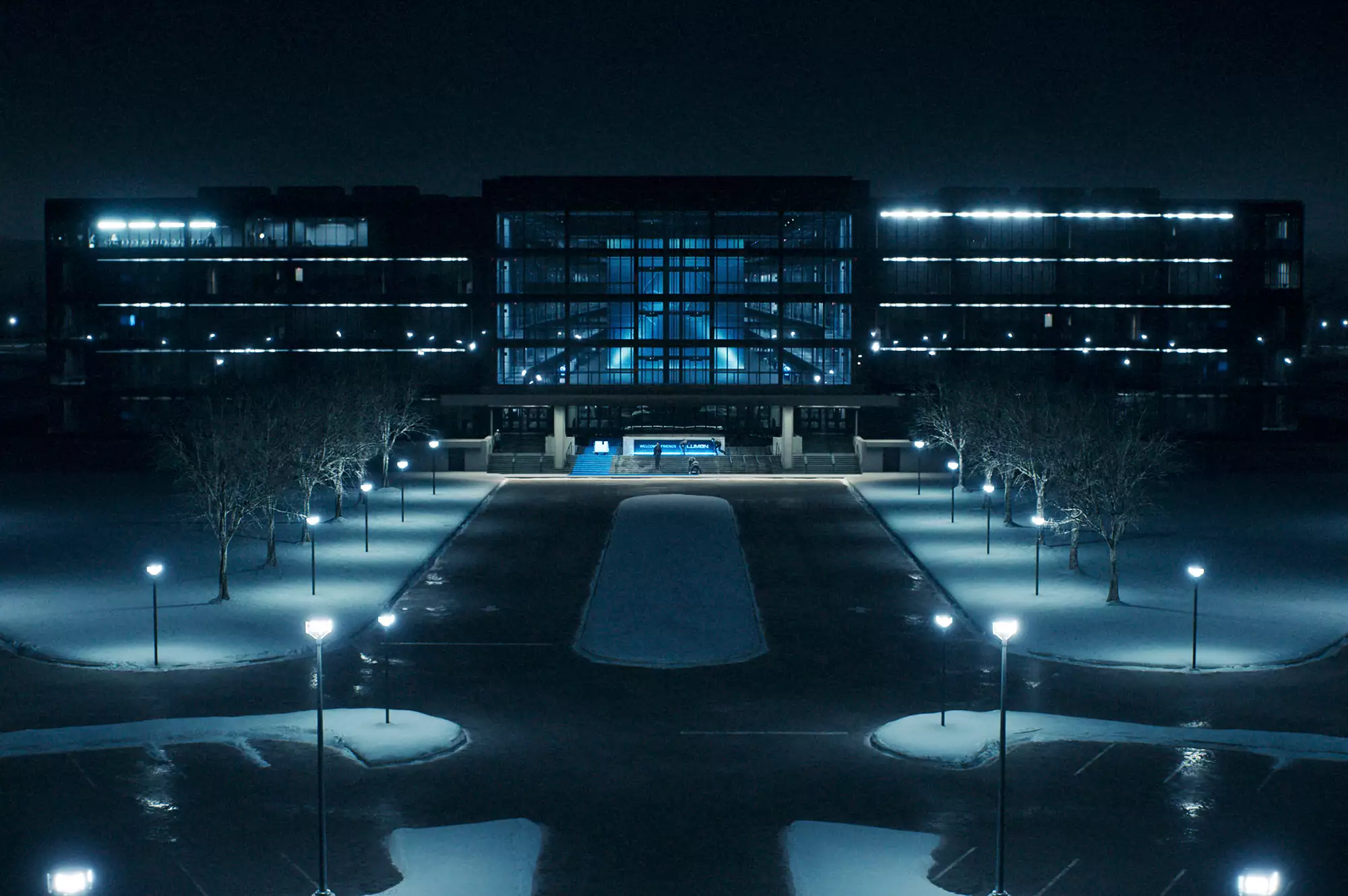The Dreaming Space of Separation: Decoding the Architectural Poetics Behind Lumon Headquarters.
When Apple TV+’s Severendance slices through the pain of workplace alienation with an icy blade, the spine-tingling Lumon HQ has long been a visual totem in viewers’ collective memory. This concrete labyrinth that devours humanity has surprising flesh and blood in the real world – it not only carries the codes of half a century of architectural history, but is also a spatial experiment in power, memory, and freedom.
Bell Labs: The Twilight of a Technological Utopia.
Through the glass walls of Holmdel, New Jersey, Bell Labs, which opened in 1962, looks like a sleeping steel beast. This modernist temple, built by architects Eero Saarinen and Kevin Roche, once shuddered and roared with the invention of the transistor and the laser. When the Severance production team first entered the relic, which has been converted into a commercial complex, director Ben Stiller paused long enough in front of the reflective glass: “Those panes refract the sky like a million watchful eyes – the perfect vessel for Lumon desire for control.
Production designer Jeremy Sindel still remembers the shudder he felt when he first saw the building: “The symmetrical to the point of paranoia facade, the concrete plaza that swallows the sound of footsteps, every inch of space here whispers order and obedience. The visual team used digital technology to erase the surrounding pyrotechnics, transforming the parking lot into a desert that devours freedom. The temple that once gave birth to a technological revolution is transformed on camera into a Tower of Babel that imprisons the soul.
Poetic Construction of Data Purgatory: When Minimalism Becomes Violence.
In creating the central scene, the Macro Data Refinery Department (MDR), the production team decided to “return to the minimalist aesthetic of the 1960s. We stripped away any pretense of warmth,” Sindel strokes the cold metal edges of the desks in the scene, “Sixties desks were like instruments of torture – a fountain pen, a telephone, a stapler, that’s your whole persona as a worker.
Four desks are connected like umbilical cords to a mysterious interface in the ceiling, a deliberately infantilized design that conceals a thrilling metaphor: “As the actors huddle in this miniature cage, tapping away at their keyboards, you suddenly realize — the so-called high tech is nothing more than a New Age textile mill assembly line.”
Psychology of the Corridor: The Walking Fear Syndrome.
The winding white corridors of the Bronx studio are, in fact, carefully calculated psychological devices. When actor Adam Scott first entered this “Escher maze,” he subconsciously grabbed hold of the walls: “The suddenly widening corners, the ever-repeating door numbers gave me an eerie sense of immediacy — like running through a dream and never finding the exit.”
The most suffocating interrogation room is deliberately compressed to 2.1 meters wide, and Sindel smiles wryly from behind the monitor: “When the camera dislikes the actor’s reddened face, the physical oppression conveys the violence of the system more than any line ever could.”
White Terror: 50 Desperate Color Temperature Experiments.
To create Lumon signature “institutional paleness,” the art team conducted almost paranoid color experiments. When white sample #37 glows like an autopsy table under a cold light at 4:00 a.m., cinematographer Jessica suddenly drops the color chart: “That’s it! The kind of white that evokes the smell of disinfectant in hospital corridors.”
And the fluorescent lime green on the carpet took on an eerie life in the post-tone: “It initially resembled stale toothpaste, but when we reduced the saturation, it actually took on the hue of a newborn nursery — a perfect fit for the morbid metaphor of the ‘corporate womb.'”
Collective Traumatic Memory in Architecture
When playwright Haley awakens from the operating table, the metal countertop beneath her shimmers with an icy sheen. This prop, which the writers call the “office labor bed,” inadvertently evokes horrific memories of the audience’s birthing chair from The Handmaid’s Tale. We intentionally made all the objects familiar and alien at the same time,” says the set designer, turning the dial on the prop phone, “like when you see your own living room in a nightmare – all the furniture is there, but all the angles are wrong.
From the sharp geometric lines of John Deere’s headquarters to the mechanically dancing humanoid risers of Game Time, these ghosts of architectural history complete a grand invocation in the Lumon space. As the glass walls of Bell Labs reflect the setting sun for the last time, it’s no longer just a set for a TV show – this concrete behemoth has finally torn the veil of warmth from the modern workplace, trapping us collectively in an eternal nightmare called “work.
References
Read More
2025 Global AI Industry Report
Elon Musk Unveils Grok-3: A 200,000 GPU-Powered AI Revolution
Musk’s xAI announces Grok 3 open for free use “until the servers crash”
Manus: The AI Agent Redefining Automation in 2025



